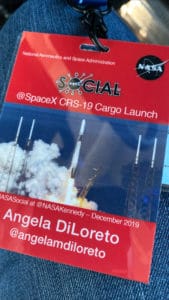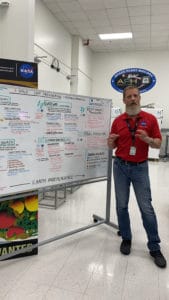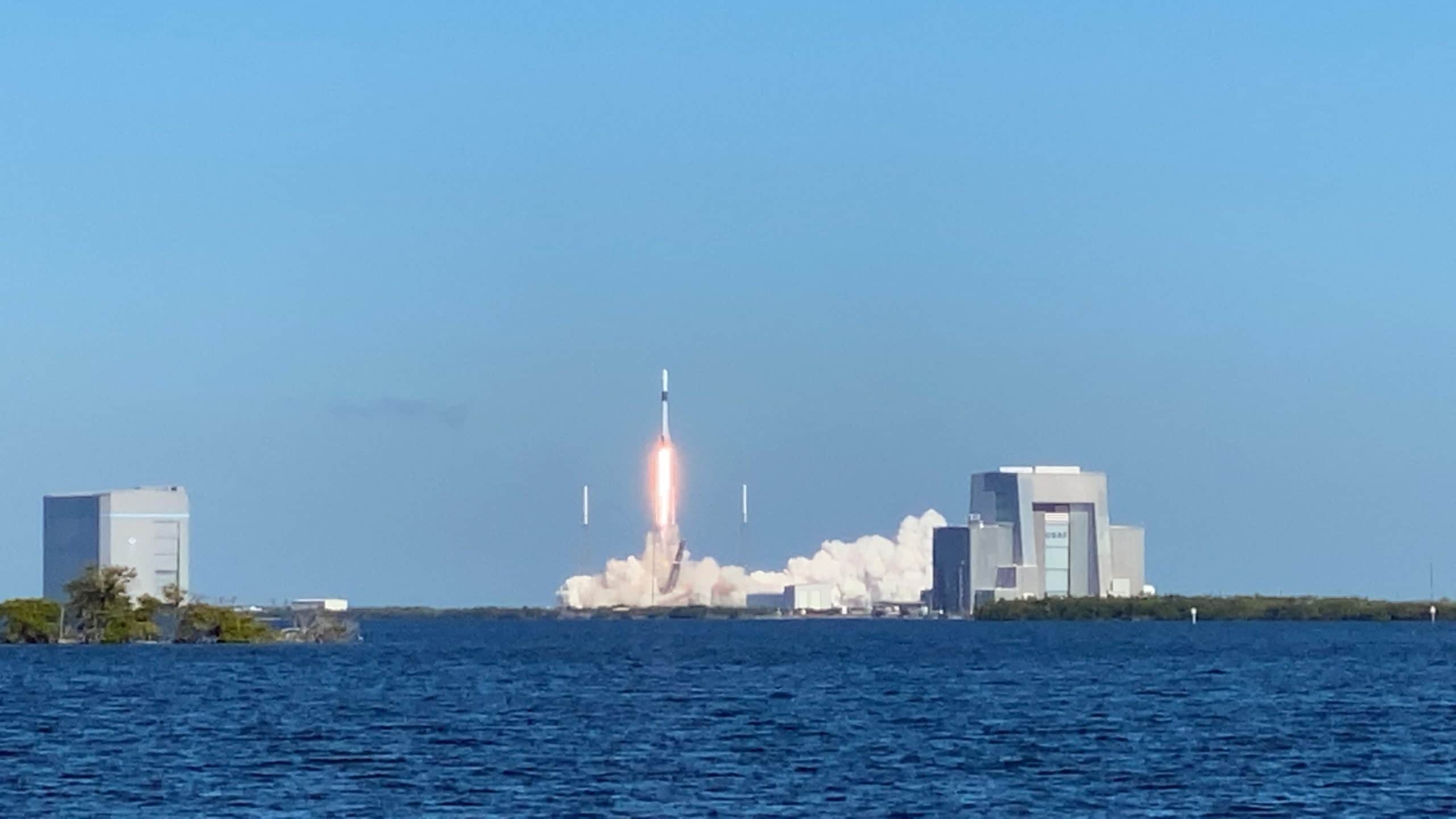I find myself sitting down to write about an experience I had in more than a month ago. Yet, still struggling to find the right words. I’m a GenXer. We grew up watching shuttle launches in the elementary school library with the rest of the school. Our parents still discussed the engineering feat of NASA landing on the moon. The nation paused in those days to watch with pride as NASA continued to amaze us with space exploration.
Disclosure: Some links on our site are affiliate links. If you purchase a linked item, we will make a commission, at no extra charge to you.
I remember as a little girl my dad (engineer for AT&T) came home and told me we could “call-in” to listen to the shuttle communicate with Houston. We called and mostly heard beeps and fuzz, but every once in a while a few words. It was exciting and to this day I am not sure we were supposed to do it, but I loved the shuttle program and my dad loved teaching me.
So, when I received an invitation to tour NASA and attend a SpaceX launch last November, it was an easy choice to head to Florida’s Space Coast.
I had no idea what I would see, the access I would be given or the stories I would hear, but I was excited! Upon landing and heading to the hotel, I drove along the Challenger Memorial Highway. The signage offered a reminder of the great achievements and losses the program has offered us all over the years. NASA has offered us the science that shapes our world, changes our world and heals our world.
I drove into a random “meeting place” parking lot and felt very James Bond-ish the next morning to meet my guide.
Random Facts about the Space Coast
- The “Space Coast” has been the center of U.S. launch activity since 1949. It was then that President Truman established the Joint Long-Range Proving Ground.
- 135 space shuttle flights originated on the Space Coast
- 20,830 orbits were completed by NASA space shuttles
What happens when NASA invites you to a launch?

The invitation arrived to attend the SpaceX Falcon 9 launch of Dragon about a month before “go for launch.” You don’t get much information initially. Basically, be here (random parking lot) at this time. What you will need and what not to wear/do. The expected launch date is for X, but added a disclaimer. “Launching into space is a very complex business. Many different factors can cause a scheduled launch date to change numerous times.”
A few days before the event I received a tentative agenda. It included a list of NASA acronyms as the agenda. So, I headed to Google and got excited as it came into focus!
The day of the event you arrive to what appears to be a random parking lot but is actually just outside the gates. You check-in, receive your badges and your adventure begins!
Note: I also knew the launch would be a SpaceX CRS-19 commercial resupply mission contracted by NASA. It would include a Falcon 9 rocket launching from a NASA launchpad. The capsule returned to earth 32 days later.
The NASA Veggie Lab

As we enter the building housing the “Veggie Lab” we are met with the best NASA poster so far. Walking into the laboratory I am surprised to discover I am standing in the actual laboratory, not a press staging area, but the real deal. To my left, I notice a large whiteboard with notes.

Guided through the laboratory by the Senior Project Manager for Space Crop Production in Support of Deep Space Exploration, I learned more about the “space veggies.” His title tells a lot about what they are doing in the lab. We need to be able to grow food if we go deeper into space. With plans for a Mars expedition, our astronauts will need veggies.
While listening I was somewhat mesmerized by the board. Filled with words like “hostile environment” and “deep-space radiation” I was in awe of what NASA scientists can achieve. Yes, it was some not so simple tomatoes that brought me to that awareness.
Currently, the project is focusing on pick and eat varieties (small tomatoes and radishes) due to the degradation of nutrients. The plants were beautiful and grown in “Chi a Pet-type” pods.
Vehicle Assembly Building (VAB)


This is the building you see when NASA is mentioned. This is the building synonymous with NASA and space exploration. Greg, our guide, who we called Rocket Dad as he kept us in line, retired from work as an engineer in this building. He led us into the building and I heard him snicker slightly. We were under strict instructions not to stop and not to wander off as this is not a part of a “normal” tour, but as I walked in I couldn’t help it. I stopped dead in my tracks and said, “Holy shit!” It was the enormity of the building. It was the history of the building. It was memories of shuttles suspended on the evening news being prepped for launches. It was a place of childhood space dreams! Greg smiled and responded with, “I know.” I doubt the awe of what those walls have witnessed would ever wear off.
Visiting Launch Pads
Our first launch pad visit was historic launch pad 39B. It doesn’t sound so impressive that way though, does it? It was the pad built to support the Apollo program. As the vehicle skirted the edge and pulled into the pad’s flame trench, the sun hit the metal upright beams to welcome us. The enormity of launching more than 50 missions could be felt. Its launches included Challenger’s last mission and most the Apollo missions. It will be the launch site for Artemis 1 in 2020 as we return to the moon too.

Boeing has a rocket out for a dry test so our guide, Greg made a quick stop to give us a closer look.
This was it! This was my first look at the rocket I would later watch launch into space!

What was Dragon’s Mission?
Here’s the official “what’s onboard”
Dragon took 38 experiments to the International Space Station. These experiments reach beyond space applications and serve to help people here on Earth. This is science that shapes our world, changes our world and heals our world.
I was surprised to find out Budweiser has been experimenting on ISS for the past three years. Yes, you read that right…space beer. But actually, it is much more entailed than just beer. They are evaluating germination and gene expression of barley in space. Dragon carried the fourth payload to build on previous experiments.
Dragon also carried an experiment by Case Western Reserve University to study flame spread in confined spaces. This will give firefighters on Earth a better understanding of the physics of flame spread which will save lives and reduce property loss.
The stars of the launch were the Mighty Mice! The name immediately made me think of the old Mighty Mouse cartoon. But the Mighty Mice are headed to space, in this case, to “save the day.” The Rodent Research 19 (RR19) team is studying myostatin. Myostatin is the growth factor that limits muscle growth in mice and humans. A better understanding of myostatin will lead to better treatments for those suffering from muscle and bone loss on Earth. It will also help to ensure the safety of future astronauts in space. The stars of the launch were the Mighty Mice! The name immediately made me think of the old Mighty Mouse cartoon.
The mice have been genetically engineered to lack skeletal muscles and have an increased body mass (about double a normal mouse). Initial myostatin studies show a “dramatic increase in bone density.”
Kennedy Space Center
- Kennedy Space Center is located on Merritt Island. KSC spreads across 219 square miles northwest of Cape Canaveral.
- Location of the Race to the Moon (well where the launch that won it originated).
- Kennedy Space Center Visitor Complex hosts about 1.5 million visitors every year.
- In 2013, the space shuttle Atlantis display opened. Atlantis flew the shuttle program’s last-ever mission. (Touched down for good on July 21, 2011.)
The Launch
The original launch date of December 4, 2019, scrapped due to high atmospheric winds. We re-gathered the next day along the causeway in hopes of better conditions. It was a beautiful day, but it seemed beautiful the day before too. The long-range tracking camera was positioned and ready nearby. (I missed that photo in my excitement) I set up my chair and held my iPhone Pro Max. Determined to live in the moment and not behind a camera lens I brought only my trusty iPhone. The loudspeaker was giving updates as we all waited in excitement. Then I heard it. “Go for launch” and I teared up. We were close and about to see what I had watched so many times on television as a kid. Remembering what a fan of this my dad was I reached for my dragonfly (urn) necklace to hold during the take-off.
The steam began to rise and the rocket slowly lifted towards the sky. The rumble came next. It was a rumble you could feel in every cell of your body. Next came the glow. A glow so bright it made the bright sun of the Florida sky seem to dim. We stood in awe as SpaceX’s Dragon lifted higher into the sky. I looked over at the group and saw I wasn’t the only one to tear up.

Surprises (to me) on the Space Coast
- The plumes you see during a launch are not smoke. It is water and used as a sound suppression system.
- Kennedy Space Center is a wildlife preserve. I saw bald eagles, wild pigs, cranes, numerous types of birds and, of course, alligators. Yes, it is where gators and wildlife live side-by-side with our most advanced science.
- Astronauts experience 16 sunrises and sunsets per day, which for this sunset (and sunrise) lover would be amazing!
Re-embrace your love of space exploration and book your trip! Here are some tips for your Kennedy Space Center trip.
- Walk the grounds. Remember the triumphs and tragedies of our childhood. (Kennedy Space Center’s Visitors Center is opened to the public. Some accounts in this article will not be available for public visits.)
- Feel free to ask me more about the trip on social media (Twitter, Facebook, Instagram).
If you’re not ready to book a trip, you can still enjoy the launch coverage.
- Give #NASASocial a follow to enjoy the launch coverages (Twitter, Facebook, YouTube).
- Browse NASA images on Creative Commons.
This is where the science that shapes our world is born. NASA has shown us worlds beyond our own and the best may be yet to come. As we return to the moon and beyond, a whole new generation of space enthusiasts will be born. The best may be yet to come.


Comments are closed.